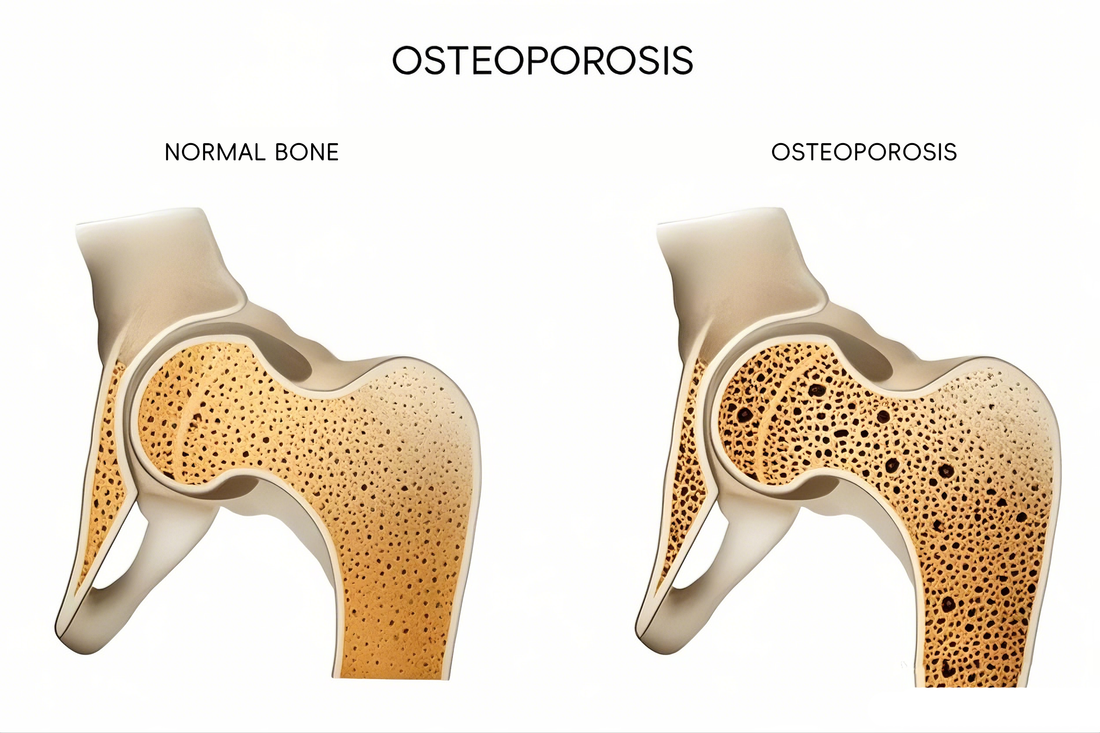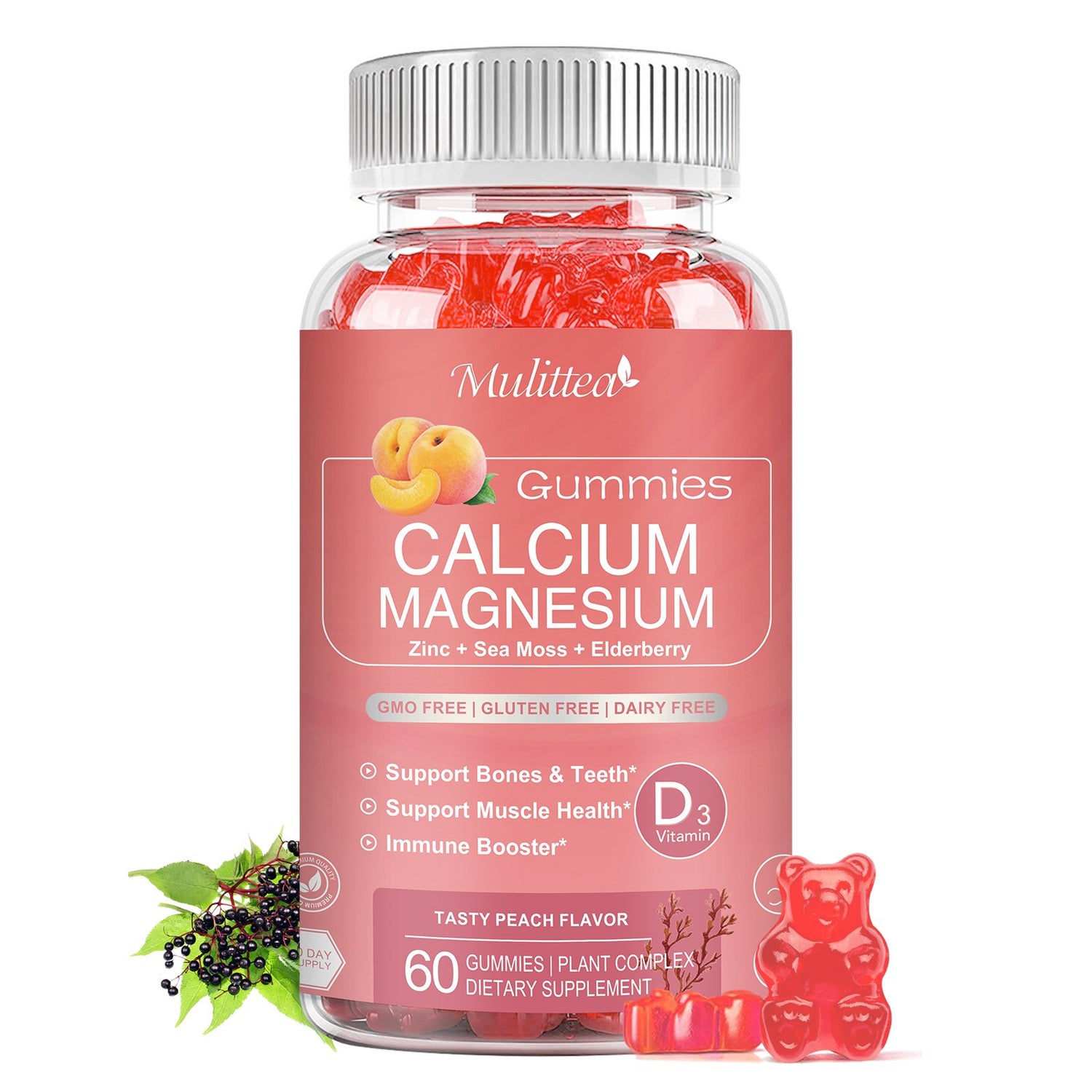
Understanding Osteoporosis: Key Causes, Symptoms, and Prevention Tips
Share
Osteoporosis, often called the “silent disease,” is a condition that gradually weakens bones, making them fragile and more likely to break. It affects millions of people worldwide, yet many don’t know they have it until they experience a bone fracture. This article will provide a comprehensive understanding of osteoporosis, explore its causes and symptoms, and offer prevention strategies to maintain strong, healthy bones.
What is Osteoporosis?
Osteoporosis is a condition characterized by low bone mass and deterioration of bone tissue, leading to increased bone fragility. In a healthy body, bones are continuously being broken down and rebuilt in a process called bone remodeling. However, in people with osteoporosis, the creation of new bone doesn’t keep up with the loss of old bone. This imbalance weakens the bones, making them more prone to fractures, even with minimal impact.
Bones affected by osteoporosis can become porous and brittle, and even routine activities like bending over, coughing, or lifting something heavy can lead to fractures. These fractures often occur in the hip, spine, and wrist, causing significant pain and reduced mobility.
Key Causes of Osteoporosis
Understanding the key causes of osteoporosis is the first step toward prevention and management. Several factors contribute to the development of this bone condition:
Genetics and Family History
- One of the most significant risk factors for osteoporosis is family history. If you have a parent or sibling with osteoporosis or a history of fractures, you may be at a higher risk of developing the condition yourself.
- Genetic factors influence bonedensity, and some people inherit a tendency to have thinner bone It’s important to be aware of your family’s medical history to take preventive measures early.
Age
- As we age, bone mass naturally decreases. From around the age of 30, bone density begins to decline, and the process accelerates as people get older.
- Postmenopausal women, in particular, experience a sharp decline in bonedensity due to lower estrogen levels. Estrogen plays a critical role in maintaining bone strength, and its reduction leads to an increased rate of bone
Gender
- Women are at a significantly higher risk for osteoporosis than men, particularly after menopause. This is due to hormonal changes that affect calcium absorption and bone
- Estrogen, the hormone that decreases sharply after menopause, helps protect bone. With its reduction, women experience a higher rate of boneloss, putting them at risk for osteoporosis. In contrast, men’s testosterone levels decline gradually, and they generally experience less bone loss than women.
Nutrient Deficiencies
- Calcium: Calcium is the most essential nutrient for bone health, as it provides structure to bone. A deficiency in calcium can lead to weakened bones, increasing the risk of fractures.
- Vitamin D: Vitamin D is necessary for the absorption of calcium from food. Without adequate vitamin D, your body cannot absorb enough calcium to keep bones strong.
- Magnesium: Magnesium helps regulate calcium levels and is vital for bone A lack of magnesium can interfere with bone strength and increase the risk of osteoporosis.
Lifestyle Factors
- Sedentary Lifestyle: Physical activity stimulates bone formation and maintains bone density. A sedentary lifestyle, particularly one that lacks weight-bearing exercises, weakens bones over time.
- Smoking: Smoking reduces bone density by decreasing blood supply to the bones and interfering with calcium It also negatively affects bone-forming cells.
- Excessive Alcohol Consumption: Drinking alcohol in large amounts impairs bone health by disrupting the balance of calcium and affecting bone
Chronic Conditions and Medications
- Certain diseases like rheumatoid arthritis, type 1 diabetes, and chronic kidney disease increase the risk of osteoporosis. These conditions can either directly affect bone density or contribute to a lack of calcium.
- Long-term use of certain medications, especially corticosteroids, can also increase the risk of osteoporosis by interfering with bone remodeling and calcium.

Symptoms of Osteoporosis
Osteoporosis is often referred to as the "silent disease" because it develops slowly over time without obvious symptoms. However, as the condition progresses, you may begin to notice some signs:
Early-Stage Symptoms
- In the early stages, osteoporosisoften doesn’t cause any noticeable symptoms. Bone density loss can occur without pain, which is why it’s important to undergo regular bone density tests if you’re at risk.
Later-Stage Symptoms
- Fractures: The most common symptom of osteoporosis is fractures from low-impact or minimal trauma, such as a fall. Fractures often occur in the spine, hips, or wrists.
- Back Pain: Spinal fractures caused by osteoporosis can lead to severe back pain. Sometimes, the vertebrae may collapse, causing a loss of height and a hunched back.
- Postural Changes: Over time, people with osteoporosis may experience a stooping or slumping posture due to collapsed vertebrae in the spine.
- Decreased Height: A significant loss of height can occur as vertebral fractures in the spine lead to compression.
How to Prevent Osteoporosis
The good news is that osteoporosis is largely preventable with the right lifestyle choices. Here are some of the most effective prevention tips:
Balanced Diet for Bone Health
- Eating a diet rich in calcium, vitamin D, and magnesium is essential for bone health. These nutrients help strengthen bones and prevent bone
-
Include foods such as:
- Dairy products (milk, cheese, yogurt) for calcium
- Fatty fish (salmon, mackerel) and fortified foods for vitamin D
- Leafy greens (kale, spinach) and seeds for magnesium
Exercise and Physical Activity
- Weight-bearing exercises such as walking, jogging, and dancing help stimulate bone formation and increase bone density.
- Strength-training exercises (using weights or resistance bands) are essential for improving bone strength and preventing bone
- Activities like yoga and Pilates can improve flexibility, balance, and posture, which are especially important for older adults to prevent falls.
Lifestyle Changes
- Avoid smoking and limit alcohol consumption, as both negatively affect bone health.
- Maintaining a healthy weight is crucial, as being under weight can increase bone fragility, while being overweight puts excess stress on the bone
Regular Health Check-ups and Bone Density Testing
- Regular bonedensity tests (DEXA scans) can help detect osteoporosis If you’re over the age of 50 or have risk factors, it’s important to get tested.
- Monitoring your calcium and vitamin D levels, especially if you’re at risk, is key to preventing bone
Osteoporosis Treatment Options
While prevention is key, treatment options are available for those who have already developed osteoporosis:
Medications
- Several medications help to manage osteoporosis and reduce the risk of fractures. These include bisphosphonates, hormone replacement therapy, and denosumab.
- Your healthcare provider will determine the most appropriate treatment based on your individual needs.
Supplements for Bone Health
- If your diet is lacking, supplements for calcium, vitamin D, and magnesiumcan help fill in nutritional gaps and improve bone health. Mulittea's bone care supplements are an excellent option for those looking to support their bones with high-quality nutrients.
Lifestyle and Home Remedies
- In addition to medication, it’s important to maintain a bone-healthy lifestyle through regular exercise, a nutritious diet, and avoiding harmful habits like smoking and excessive drinking.
Conclusion
Osteoporosis is a serious condition that can significantly impact your quality of life. However, with the right knowledge and proactive steps, you can prevent and manage osteoporosis effectively. By maintaining a balanced diet, staying active, and getting regular check-ups, you can ensure that your bones remain strong and healthy throughout your life.
Start today by taking control of your bone health, and consider supplementing your diet with bone-boosting nutrients like calcium, vitamin D, and magnesium.
References
- National Osteoporosis "What Is Osteoporosis?" National Osteoporosis Foundation, 2021, www.nof.org/patients/what-is-osteoporosis/.
- NIH Osteoporosis and Related Bone Diseases National Resource Center. "Osteoporosis" National Institutes of Health, 2021, www.bones.nih.gov/health-info/bone/osteoporosis.
- "Calcium and Bone Health." Harvard Health Publishing, 2020, www.health.harvard.edu/topics/calcium-and-bone-health.

